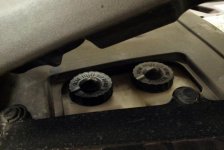Yes SPYRYDER, I see the vent hole on that 1955 Ford cap, but was there or was there not a rubber diaphrgam under it, and that hole was to let air out from cap and diaphragm?
I just returned from removing the Clutch Master Cylinder Cover on my 2009 RS SM5, and yes it has two identations on the cover where it meets the main body of the master cyclinder. I removed the rubber diaphragm with the sight glass, washed very well with brake clean and dryed with gentle air pressure and I see the two dimples. I examined the diaphragm very carefully trying to see if there were holes in them there dimples- no holes and no other holes anywhere else.
The reason the brake fluid is so dirty and blackish in color, in that clutch master cylinder is due to the brake fluid disolving the BRP o-rings, which are black. Eventually you have to replace them o-rings and bled the system with new/clean brake fluid, because you will not be able to disengage the clutch. Why did BRP use o-rings that do not like brake fluid? I found the o-rings in question in th 2009 RS SM5 parts section of BRP, Section-05- Diaphragm Cover #10-part#420431441, #11-part#420431301 and #13-part#42063189. Also when servicing these o-rings check the PISTON they go on for wear/scuffing, #9-part#420656122.
And, like SPYRYDER, I love and happy with my two 2009 RS SM5 Spyders, one has 16,000 miles and the other has 12,000 miles. My best friend is on his second Spyder 1st-2008 RS SM5 11,000 miles and his current one is a 2011 RT SM5 with 21,000 miles. I try and do as much service to all three, the RS's are a dream to work on, that RT is a bear to work on, and is constantly in and out of the dealers with bull**** problems

